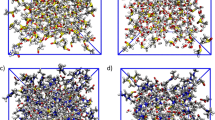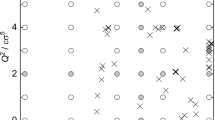Abstract
In this study, the perturbed hard sphere chain equation of state is utilized to calculate the activity of water in binary and ternary solutions of polyethylene glycol (PEG), salt and water. The liquid density of the binary and ternary solutions is also predicted. To estimate the water activity in PEG–water binary systems, a linear correlation is obtained for the binary interaction parameter between water and PEG. Then, using this correlation and without introducing any additional binary parameters, the water activities are predicted in ternary solutions of water, salt and PEG with different molecular weights (MW). Our results show that the mean absolute average relative deviation (AARD %) of water activity for binary PEG–water solutions in 298 K is 0.73 %. In addition, the water activity in ternary solutions of water and two PEGs with different MW is predicted within 0.31 % AARD %. Furthermore, the AARD % for prediction of water activities in binary PEG–water solutions over the temperature range 308–338 K is 0.41 %. Also, the water activities of aqueous two-phase systems are predicted with AARD % = 0.64 %. In this regard, no adjustable parameters were correlated between salt and PEG. Finally, liquid densities were predicted in binary solutions of water–PEG and ternary solutions of water–PEG–salt.





Similar content being viewed by others
Abbreviations
- k ij :
-
Binary interaction parameter
- R:
-
Number of segments
- T :
-
Temperature (K)
- x i :
-
Mole fraction of component i
- Z :
-
Compressibility factor
- EoS:
-
Equation of state
- OF:
-
Objective function
- PHSC:
-
Perturbed hard sphere chain
- SAFT:
-
Statistical associating fluid theory
- Assoc:
-
Association term
- Cal:
-
Calculated
- Expt:
-
Experimental
- Ref:
-
Reference
- Pert:
-
Perturbation term
- i, j :
-
Component index
- ε :
-
Dispersion energy parameter (J)
- εAB:
-
Energy parameter of the association between sites A and B (J)
- ρ :
-
Number density (number of molecules in unit volume), (Å−3)
- σ :
-
Temperature independent segment diameter (Å)
- κ AB :
-
Volume of interaction between sites A and B
References
Haghtalab, A., Mokhtarani, B.: On extension of UNIQUAC–NRF model to study the phase behavior of aqueous two phase polymer–salt systems. Fluid Phase Equilib. 180, 139–149 (2001)
Ninni, L., Camargo, M.S., Meirelles, A.J.A.: Water activity in poly(ethylene glycol) aqueous solutions. Thermochim. Acta 328, 169–176 (1999)
Herskowitz, M., Gottlieb, M.: Vapor–liquid equilibrium in aqueous solutions of various glycols and poly(ethylene glycols). 2. Tetraethylene glycol and estimation of UNIFAC parameters. J. Chem. Eng. Data 29, 450–452 (1984)
Sadeghi, R.: A modified segment-based nonrandom two-liquid model for the calculation of vapor–liquid equilibrium of aqueous polymer–salt solutions. Chem. Eng. Sci. 61, 7786–7794 (2006)
Haghtalab, A., Joda, M.: Modification of NRTL–NRF model for computation of liquid–liquid equilibria in aqueous two-phase polymer–salt systems. Fluid Phase Equil. 278, 20–26 (2009)
Xu, X., Madeira, P.P., Teixeira, J.A., Macedo, E.A.: A new modified Wilson equation for the calculation of vapor–liquid equilibrium of aqueous polymer solutions. Fluid Phase Equil. 213, 53–63 (2003)
Song, Y., Lambert, S.M., Prausnitz, J.M.: A perturbed hard-sphere-chain equation of state for normal fluids and polymers. Ind. Eng. Chem. Res. 33, 1047–1057 (1994)
Chiew, Y.C.: Percus–Yevick integral-equation theory for athermal hard-sphere chains. Mol. Phys. 70, 129–143 (1990)
Feng, W., Hao, W., Xu, Z., Wang, W.: Comparison of perturbed hard-sphere-chain theory with statistical associating fluid theory for square-well fluids. Ind. Eng. Chem. Res. 39, 2559–2567 (2000)
Favari, F., Bertucco, A., Elvassore, N., Fermeglia, M.: Multiphase multicomponent equilibria for mixtures containing polymers by the perturbation theory. Chem. Eng. Sci. 55, 2379–2392 (2000)
Doghieri, F., Angelis, D.E., Baschetti, M.G., Sarti, G.C.: Solubility of gases and vapors in glassy polymers modeled through non-equilibrium PHSC theory. Fluid Phase Equilib. 241, 300–307 (2006)
Hino, T., Song, Y., Prausnitz, J.M.: Equation-of-state analysis of binary copolymer systems. 1. Screening effect. Macromolecules 28, 5709–5716 (1995)
Hino, T., Song, Y., Prausnitz, J.M.: Equation-of-state analysis of binary copolymer systems. 3. Miscibility maps. Macromolecules 28, 5725–5733 (1995)
Hino, T., Song, Y., Prausnitz, J.M.: Equation-of-state analysis of binary copolymer systems. 2. Homopolymer and copolymer mixtures. Macromolecules 28, 5717–5724 (1996)
Hino, T., Prausnitz, J.M.: Lower and upper critical ordering temperatures in compressible diblock copolymer melts from a perturbed hard-sphere-chain equation of state. Macromolecules 31, 2636–2648 (1998)
Ko, S.J., Kim, S.J., Kong, S.H., Bae, Y.C.: Theoretical consideration on phase behaviors of poly(ethyleneoxide-block-propylene oxide)/LiCF3SO3 systems in lithium battery. Electrochim. Acta 49, 461–468 (2004)
Gupta, B. Vapor–liquid equilibria for polymer + solvent systems: effect of “intermolecular repulsion”. PhD thesis, University of California, Berkeley (1995)
Valavi, M., Dehghani, M.R.: Application of PHSC equation of state in prediction of gas hydrate formation. Fluid Phase Equilib. 333, 27–37 (2012)
Valavi, M., Dehghani, M.R., Feyzi, F.: Calculation of liquid–liquid equilibirum in polymer electrolyte solutions using PHSC–electrolyte equation of state. Fluid Phase Equilib. doi:10.1016/j.fluid.2012.12.007
Lee, B.S., Kim, K.C.: Phase equilibria of associating fluid mixtures using the perturbed-hard-sphere-equation of state combined with the association model. Korean J. Chem. Eng. 24, 133–147 (2007)
Wertheim, M.S.: Fluids with highly attractive forces. J. Stat. Phys. 35, 19–34 (1984)
Wertheim, M.S.: Fluids with highly directional attractive forces. II. Thermodynamic perturbation theory and integral equations. J. Stat. Phys. 35, 35–47 (1984)
Wertheim, M.S.: Fluids with highly attractive forces. J. Stat. Phys. 42, 459–467 (1986)
Wertheim, M.S.: Fluids with highly directional attractive forces. IV. Equilibrium polymerization. J. Stat. Phys. 42, 477–492 (1986)
Wertheim, M.S.: Fluids of dimerizing hard sphere and fluid mixtures of hard spheres. J. Chem. Phys. 85, 2929–2935 (1986)
Wertheim, M.S.: Thermodynamic perturbation theory of polymerization. J. Chem. Phys. 87, 7323–7345 (1987)
Paredes, M.L.L., Nobrega, R., Tavares, F.W.: An equation of state for polymers and normal fluids using the square-well potential of variable well width. Ind. Eng. Chem. Res. 40, 1748–1754 (2001)
Trivedi, S., Bhanot, C., Pandey, S.: Densities of over the temperature range (283.15 to 363.15). J. Chem. Thermodyn. 42, 1367–1371 (2010)
Eliassi, A., Modarress, H., Mansoori, G.A.: Measurement of activity of water in aqueous poly(ethylene glycol) solutions (effect of excess volume on the Flory Huggins ø-parameter). J. Chem. Eng. Data 44, 52–55 (1999)
Lin, D.-Q., Mei, L.H., Zhu, Z.-Q., Han, Z.-H.: An improved isopiestic method for measurement of water activities in aqueous polymer and salt solutions. Fluid Phase Equilib. 118, 241–248 (1996)
Salabat, A., Nasirzadeh, K.: Measurement and prediction of water activity in PEG + (NH4)2SO4 + H2O using polymer scaling law. J. Mol. Liquids 103–104, 349–368 (2003)
Lin, D.-Q., Zhu, Z.-Q., Mei, L.H., Yang, L.R.: Isopiestic determination of the water activities of poly(ethyleneglycol) + salt + water systems at 25°C. J. Chem. Eng. Data 41, 1040–1042 (1996)
Ochs, L.R., Kabiri-Badr, M., Cabezas, J.H.: An improved isopiestic method to determine activities in multicomponent mixtures. AIChE J. 36, 1908–1912 (1990)
Rahbari-Sisakht, M., Taghizadeh, M., Eliassil, A.: Densities and viscosities of binary mixtures of poly(ethylene glycol) and poly(propylene glycol) in water and ethanol in the 293.15–338.15 K temperature range. J. Chem. Eng. Data 48, 1221–1224 (2003)
Cruz, R.D.C., Martins, R.J., Cardoso, D.M.C.M., Barcia, O.E.: Volumetric study of aqueous solutions of polyethylene glycol as a function of the polymer molar mass in the temperature range 283.15 to 313.15 K and 0.1 MPa. J. Solution Chem. 38, 957–981 (2009)
Eliassi, A., Modaress, H., Mansoori, G.A.: Densities of poly(ethylene glycol) water mixtures in the 298.15–328.15 K temperature range. J. Chem. Eng. Data 43, 719–721 (1988)
Zafarani-Moattar, M.T., Kabiri-Badr, M.: Volumetric properties of PEG + salt + water. Chem. Eng. Data 40, 559–562 (1995)
Author information
Authors and Affiliations
Corresponding author
Rights and permissions
About this article
Cite this article
Valavi, M., Shirazian, S., Pour, A.F. et al. Calculation of the Density and Activity of Water in ATPS Systems for Separation of Biomolecules. J Solution Chem 42, 1423–1437 (2013). https://doi.org/10.1007/s10953-013-0040-8
Received:
Accepted:
Published:
Issue Date:
DOI: https://doi.org/10.1007/s10953-013-0040-8




